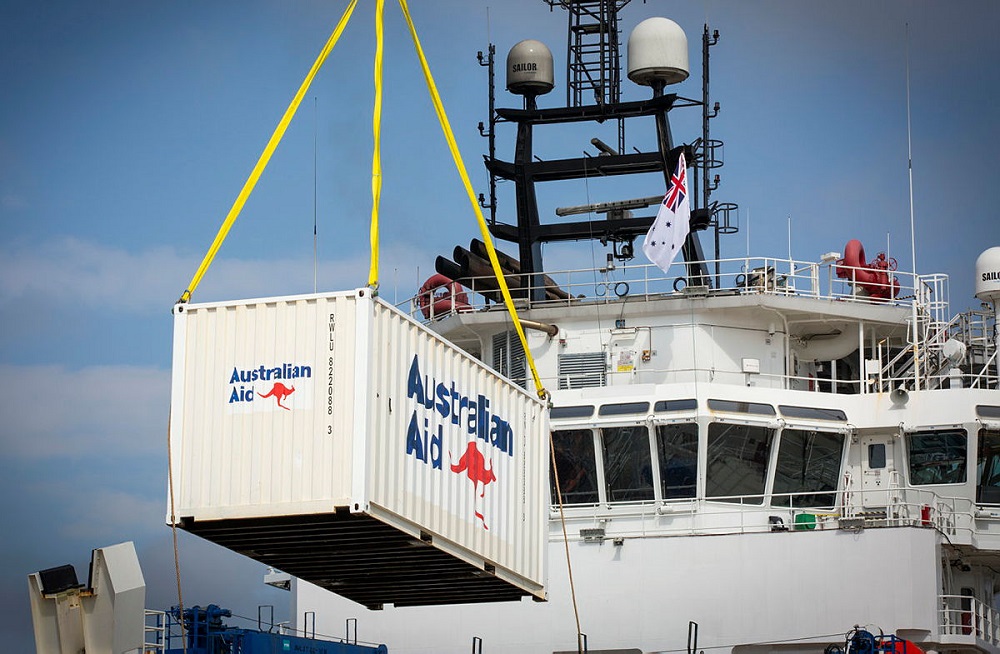
The government’s new international development policy, released last week, has some interesting implications for defence. In particular, it completes the process of aligning messaging across the different arms of statecraft on their important and complementary roles in a difficult and complex world.
The policy’s aim is ‘a peaceful, stable and prosperous Indo-Pacific’. This frames development objectives along similar lines to the defence strategic review. Like the DSR, the development policy identifies Australia’s challenging strategic circumstances, including climate change, global economic uncertainty and geostrategic competition.
Given that 22 of Australia’s 26 nearest neighbours are developing countries, and many are fragile, an effective development program is key to building regional resilience. Minister for International Development and the Pacific Pat Conroy introduced the policy saying that ‘the success of Australia’s region is also our success’ and that positive development outcomes are ‘firmly in Australia’s national interest’. This message to Australia’s neighbours is equally relevant for defence diplomacy.
The development program is presented as a crucial mechanism at the heart of Australia’s response to an uncertain world. As Minister for Foreign Affairs Penny Wong puts it, ’development underpins stability’. The policy explains that if Australians want to live in a predictable world, we have to lift people out of poverty through sustainable development.
This puts defence and development in the same frame as contributors to national goals of regional stability, prosperity and predictability.
The policy explicitly takes a whole-of-government and whole-of-nation approach, using similar wording to the DSR about ‘all elements of national power’. Speaking at the launch, Wong said that in light of ‘the most challenging strategic circumstances in many generations … our nation has to deploy all of our national power—all tools of statecraft—to help shape the region we want.’
This brings a range of departments and agencies into a conversation about how they can contribute to international objectives. For example, the policy includes a case study of the Pacific Australia Labour Mobility program to illustrate ‘how strong policy coherence across different tools of statecraft can deliver benefits for both Australia and our region’.
The policy stresses the importance of these different elements working together and commits to improving the integration of development with other tools of statecraft, including through ‘whole-of-government governance structures’.
The Department of Foreign Affairs and Trade is recognised as playing the role of lead agency on implementing official development assistance, wherever it’s delivered. This means that the DFAT reporting requirements set out in the policy’s performance and delivery framework will apply to other parts of government that manage development assistance programs.
The heavy lifting in the policy will be done by country-level development partnership plans led by Australian overseas missions. This provides an opportunity for them to incorporate a whole-of-government perspective, given that each mission is a microcosm of myriad agencies and departments.
A salient feature of the new policy is its embedding of important themes across the whole development program.
Climate change is identified as a development priority and cross-cutting theme. Climate risk must be considered in all bilateral and regional development partnership plans. And, from next year, at least 50% of all new investments over $3 million must have a climate change objective, with a goal of reaching 80% in 2028–29. According to DFAT, the proportion of projects with climate change objectives is currently around 25%.
Gender equality—along with disability equity—is a ‘core issue for action’. Already there’s a target for 80% of all overseas development investment to address gender equality effectively. Now all new investments over $3 million must include gender equality objectives.
It is an approach that pushes change within the department—everyone will be responsible for meeting those climate and gender equality targets. There’s anecdotal evidence that it is already having an effect, with reports of controlled panic among staff who will now have to identify a climate focus in their projects.
Other notable elements include the commitments to create a civil-society partnerships fund to counter the shrinking of civil space in many parts of the world, to embed First Nations Australians’ perspectives in the development program, to create a cadre of senior responsible officers at posts, and to create a new development portal to increase accessibility and transparency of information on the development program.
So, what comes next?
One of the commitments in the policy is to create a whole-of-government humanitarian policy, which should put flesh on the bones of how to ensure an adaptable, responsive and effective framework to address humanitarian need and build resilience. The process is expected to commence in September across the whole of government, and defence should be strongly involved.
Work will also continue on a new international gender equality strategy that will apply across government.
Overall, the policy makes a bold statement. Like the DSR, it unapologetically presents the case to Australians that a deteriorating strategic environment will require greater investment in Australia’s international tools.
The policy deserves to be read widely—including by those who work on Australia’s defence—to consider how multiple elements of statecraft can contribute to security and stability.

